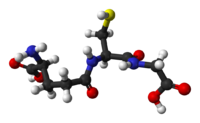
Photo from wikipedia
A silicon/polyaniline/horseradish peroxidase enzyme (n-Si/PANI/HRP) electrode was obtained by potentiostatic electrodeposition processes. PANI thin films were electropolymerized on a silicon substrate at different electric potentials, and an HRP enzyme was… Click to show full abstract
A silicon/polyaniline/horseradish peroxidase enzyme (n-Si/PANI/HRP) electrode was obtained by potentiostatic electrodeposition processes. PANI thin films were electropolymerized on a silicon substrate at different electric potentials, and an HRP enzyme was electrodeposited on the best PANI thin film. The best PANI thin film was obtained under electrodeposition conditions of + 1.00 V (vs. Ag/AgCl) and 900 s, and the immobilization of the HRP enzyme was performed at an electric potential of − 0.50 V (vs. Ag/AgCl). The n-Si/PANI- and n-Si/PANI/HRP electrodes were characterized using scanning electron microscopy and atomic force microscopy. The detection capacity of the glyphosate of the n-Si/PANI/HRP electrode with the best morphological characteristics was evaluated according to the electric current density responses from the oxidation of hydroquinone molecules in a solution containing different concentrations of glyphosate. The detection was performed because of the inhibition of the HRP enzyme activity by the glyphosate molecules in the solutions with a lower concentration limit of 5.44 μg L −1 over an electric potential range of + 0.65 to + 1.15 V (vs. Ag/AgCl).
Journal Title: Journal of Materials Science: Materials in Electronics
Year Published: 2020
Link to full text (if available)
Share on Social Media: Sign Up to like & get
recommendations!